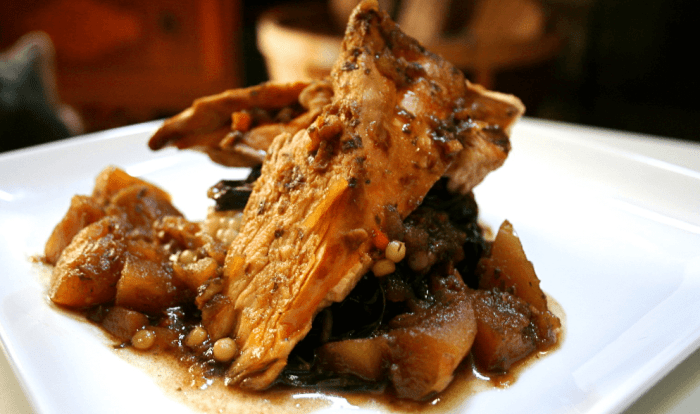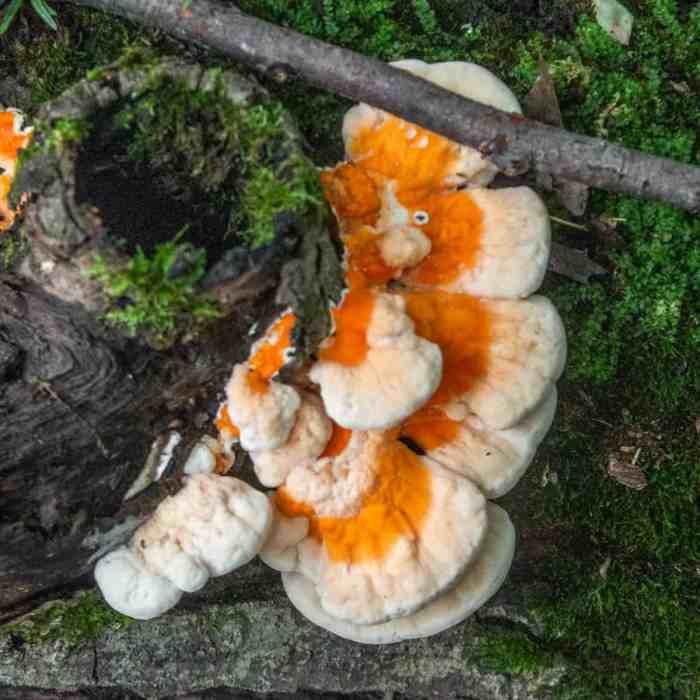
Step into the realm of culinary adventure with our comprehensive guide to the chicken of the woods recipe. This vibrant and versatile mushroom holds a special place in the hearts of foragers and foodies alike, offering a symphony of flavors and health benefits.
Join us as we delve into the fascinating world of chicken of the woods, exploring its culinary uses, nutritional value, and the art of identifying and foraging this wild delicacy.
From sautéed delights to hearty soups and savory stir-fries, chicken of the woods shines as a culinary chameleon, adapting seamlessly to a wide range of dishes. Its firm texture and mild, slightly nutty flavor make it a beloved ingredient among mushroom enthusiasts.
Introduction to Chicken of the Woods: Chicken Of The Woods Recipe

Chicken of the Woods is a vibrant and distinctive mushroom found in forests worldwide. Its unique appearance, characterized by bright orange to yellow coloration, has made it a popular choice for foragers and mushroom enthusiasts. The mushroom’s texture is tender and meaty, resembling that of chicken, giving it its name.
Its flavor is often described as earthy and slightly sweet, with a hint of citrus.
There are several species of Chicken of the Woods, each with slight variations in appearance and habitat. The most common species is Laetiporus sulphureus, known for its bright orange to yellow color and large, shelf-like growth pattern. Other species include Laetiporus cincinnatus, which has a more reddish-orange hue, and Laetiporus conifericola, found growing on coniferous trees.
Speaking of chicken of the woods recipe , I was reading about it the other day, and it’s apparently really versatile. You can fry it, grill it, or even bake it. I’m thinking about making a stir-fry with it next time.
I’ll let you know how it turns out!
Culinary Uses of Chicken of the Woods

Chicken of the Woods is a highly versatile mushroom that can be incorporated into various culinary creations. Its mild, meaty flavor and firm texture make it an excellent substitute for chicken or other meats.
Whether you’re a seasoned chef or a home cook, Chicken of the Woods offers endless possibilities. Here are some ideas to inspire your culinary adventures:
Incorporating Chicken of the Woods into Dishes
- Soups and Stews:Chicken of the Woods adds a hearty, umami-rich flavor to soups and stews. Its firm texture holds up well during cooking, making it a satisfying addition to long-simmered dishes.
- Stir-Fries:The meaty texture of Chicken of the Woods makes it an ideal ingredient for stir-fries. Slice it into strips and sauté it with your favorite vegetables and sauces for a flavorful and satisfying meal.
- Salads:Raw Chicken of the Woods can be thinly sliced and added to salads for a unique and crunchy texture. Its mild flavor complements various salad greens and dressings.
- Tacos and Burritos:Chicken of the Woods can be seasoned and grilled or pan-fried to create flavorful fillings for tacos and burritos. Its versatility allows it to be paired with various toppings and sauces.
Preparation Techniques for Chicken of the Woods
Before cooking Chicken of the Woods, it’s essential to prepare it properly:
- Cleaning:Remove any dirt or debris from the mushroom’s surface with a damp cloth or brush. Avoid using water, as it can make the mushroom soggy.
- Cutting:Cut the Chicken of the Woods into desired shapes and sizes, depending on the dish you’re preparing. For stir-fries, slice it into thin strips. For soups and stews, tear it into bite-sized pieces.
- Cooking Methods:Chicken of the Woods can be cooked in various ways. Sauté it, grill it, roast it, or add it to soups and stews. Its versatility allows you to experiment with different cooking techniques to find what suits your taste best.
Nutritional Benefits of Chicken of the Woods

Chicken of the woods is a nutritious edible mushroom that offers a range of health benefits. It is a good source of vitamins, minerals, and antioxidants.
Compared to other edible mushrooms, Chicken of the woods has a higher protein content and is a good source of fiber, potassium, and vitamin D.
Antioxidant Properties, Chicken of the woods recipe
Chicken of the woods contains several antioxidants, including ergothioneine, which has been shown to protect cells from damage caused by free radicals.
Immune Support
Chicken of the woods contains polysaccharides, which have been shown to stimulate the immune system and help protect against infections.
Anti-inflammatory Properties
Chicken of the woods contains compounds that have been shown to reduce inflammation in the body.
Potential Health Benefits
Consuming Chicken of the woods may be associated with several potential health benefits, including:
- Reduced risk of chronic diseases, such as heart disease and cancer
- Improved immune function
- Reduced inflammation
- Lower cholesterol levels
- Improved blood sugar control
Recipes and Cooking Techniques
Chicken of the Woods is a versatile mushroom that can be cooked in various ways. Sautéing is a simple and quick method that allows you to enjoy the mushroom’s delicate flavor and texture.
Here’s a recipe for a simple sautéed Chicken of the Woods dish:
Ingredients:
- 1 pound Chicken of the Woods mushrooms, cleaned and torn into bite-sized pieces
- 2 tablespoons olive oil
- 1/2 onion, chopped
- 2 cloves garlic, minced
- 1/4 cup white wine (optional)
- 1/4 cup chopped fresh parsley
- Salt and pepper to taste
Cooking Instructions:
- Heat the olive oil in a large skillet over medium heat.
- Add the mushrooms and cook until browned, about 5 minutes.
- Add the onion and garlic and cook until softened, about 3 minutes.
- Add the white wine (if using) and cook until reduced by half, about 2 minutes.
- Stir in the parsley, salt, and pepper.
- Serve immediately with crusty bread or your favorite side dish.
Identification and Foraging Tips

Identifying Chicken of the Woods accurately is crucial for safe foraging. Its distinct characteristics and look-alikes require careful attention to avoid confusion.
Hey guys, have you heard about the chicken of the woods recipe ? It’s supposed to be amazing. I’ve been thinking about trying it out for a while now, and I’m definitely going to give it a shot. The recipe seems pretty straightforward, and I’m sure it’ll be worth the effort.
Distinctive Features
- Bracket-like Shape:Chicken of the Woods grows in clusters of shelf-like brackets, with individual brackets overlapping each other.
- Bright Colors:The brackets exhibit vibrant hues, ranging from orange to yellow, with occasional pink or reddish shades.
- Pores:The underside of the brackets features tiny pores, resembling a sponge-like texture.
- Soft and Meaty:The flesh of Chicken of the Woods is soft, tender, and has a meaty texture.
Look-Alikes and Distinguishing Factors
Several fungi resemble Chicken of the Woods, but distinguishing them is essential. Here are some look-alikes and their key differences:
- False Chicken of the Woods (Hypomyces lactifluorum): Similar in shape and color, but lacks pores and has a parasitic nature.
- Chicken of the Woods False Coral (Ramaria formosa): Branched and coral-like, with a lack of pores and a tough texture.
- Cinnabar Red Polypore (Pycnoporus cinnabarinus): Bright red in color, with a hard and woody texture.
Foraging Tips
For successful Chicken of the Woods foraging, consider the following tips:
- Time:Late summer to early fall is the optimal time to find Chicken of the Woods.
- Location:Look for dead or decaying hardwood trees, especially oaks and maples.
- Habitat:Moist, shaded areas with good drainage are ideal.
- Caution:Avoid foraging in polluted areas or near treated trees.
Closing Notes

As we conclude our exploration of the chicken of the woods recipe, we hope you feel inspired to embrace the wild and incorporate this culinary treasure into your cooking. Remember, foraging for mushrooms requires knowledge and caution. If you’re new to foraging, seek guidance from experienced individuals or consult reputable resources.
With proper identification and preparation, chicken of the woods offers a delicious and nutritious addition to your culinary repertoire.
FAQ Compilation
Is chicken of the woods safe to eat?
Yes, chicken of the woods is safe to eat when properly identified and cooked. It’s important to note that some species have look-alikes that are poisonous, so it’s crucial to consult reliable resources or seek guidance from experienced foragers.
What does chicken of the woods taste like?
Chicken of the woods has a mild, slightly nutty flavor that complements a variety of dishes. Its firm texture makes it a versatile ingredient that can be sautéed, roasted, or added to soups and stews.
Where can I find chicken of the woods?
Chicken of the woods typically grows at the base of oak trees, especially in moist, shady areas. It’s most commonly found in late summer and fall.